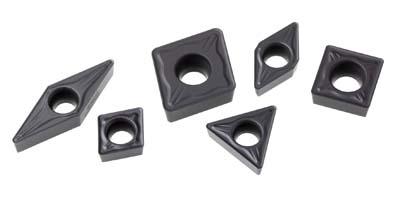
Seco's new versatile M5 positive-lock chipbreaker insert with robust geometry brings productivity and strength to turning and boring applications in steel, stainless steel, cast iron and superalloys that extend from semifinishing to the toughest roughing operations in harsh environments.
The robust M5 features a highly protected chip groove that helps tackle the most demanding operations, heavy interruptions and rough material outside skin layers. All the while, an open chip groove, with well-adapted cutting angles, ensures high feed rates and large cuts for efficient machining and best economy.
Furthermore, a finetuned chip groove provides full control while handling ductile materials. M5 achieves optimal tool life in a wide variety of workpiece materials and applications thanks to a balanced rake face that minimizes the heat transferred to the insert. M5 also can be used with Seco's Jetstream Tooling, which delivers coolant to the optimum position close to the cutting edge. The jet of coolant lifts the chip away from the rake face, improving chip control and tool life as well as allowing for increased speeds and feeds.
Available in a wide variety of grades, such as TP40, TP0500, TP1500, TP2500, TP3500, TM4000, CP500, TK1001 and TK2001, the M5 is highly effective for working on a broad range of components, including transmission parts, cylinder blocks, hubs, flanges and shafts.
Contact Details
Related Glossary Terms
- boring
boring
Enlarging a hole that already has been drilled or cored. Generally, it is an operation of truing the previously drilled hole with a single-point, lathe-type tool. Boring is essentially internal turning, in that usually a single-point cutting tool forms the internal shape. Some tools are available with two cutting edges to balance cutting forces.
- chipbreaker
chipbreaker
Groove or other tool geometry that breaks chips into small fragments as they come off the workpiece. Designed to prevent chips from becoming so long that they are difficult to control, catch in turning parts and cause safety problems.
- coolant
coolant
Fluid that reduces temperature buildup at the tool/workpiece interface during machining. Normally takes the form of a liquid such as soluble or chemical mixtures (semisynthetic, synthetic) but can be pressurized air or other gas. Because of water’s ability to absorb great quantities of heat, it is widely used as a coolant and vehicle for various cutting compounds, with the water-to-compound ratio varying with the machining task. See cutting fluid; semisynthetic cutting fluid; soluble-oil cutting fluid; synthetic cutting fluid.
- feed
feed
Rate of change of position of the tool as a whole, relative to the workpiece while cutting.
- rake
rake
Angle of inclination between the face of the cutting tool and the workpiece. If the face of the tool lies in a plane through the axis of the workpiece, the tool is said to have a neutral, or zero, rake. If the inclination of the tool face makes the cutting edge more acute than when the rake angle is zero, the rake is positive. If the inclination of the tool face makes the cutting edge less acute or more blunt than when the rake angle is zero, the rake is negative.
- superalloys
superalloys
Tough, difficult-to-machine alloys; includes Hastelloy, Inconel and Monel. Many are nickel-base metals.
- turning
turning
Workpiece is held in a chuck, mounted on a face plate or secured between centers and rotated while a cutting tool, normally a single-point tool, is fed into it along its periphery or across its end or face. Takes the form of straight turning (cutting along the periphery of the workpiece); taper turning (creating a taper); step turning (turning different-size diameters on the same work); chamfering (beveling an edge or shoulder); facing (cutting on an end); turning threads (usually external but can be internal); roughing (high-volume metal removal); and finishing (final light cuts). Performed on lathes, turning centers, chucking machines, automatic screw machines and similar machines.

